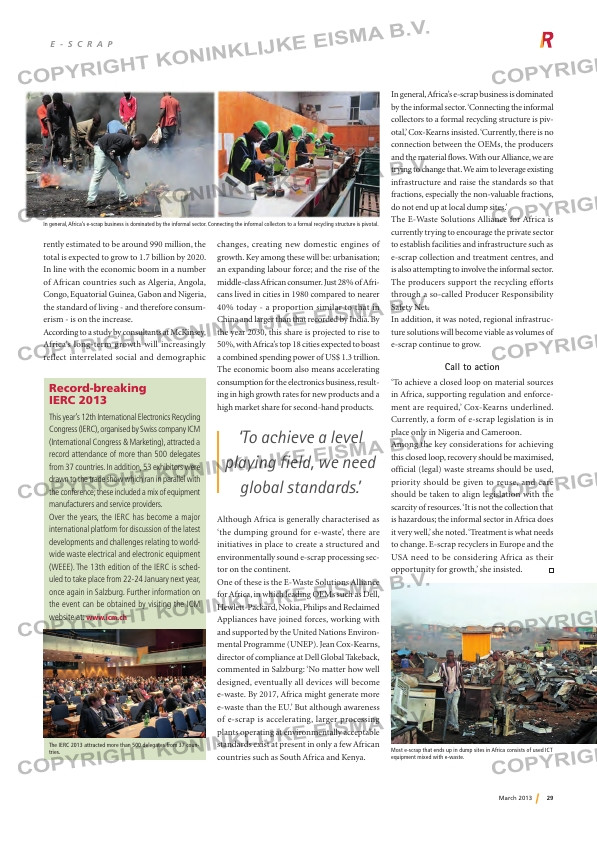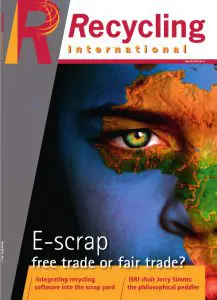Page 29 from: March 2013

29March 2013
E – s c r a p
Record-breaking
IERC 2013
This year’s 12th International Electronics Recycling
Congress (IERC), organised by Swiss company ICM
(International Congress & Marketing), attracted a
record attendance of more than 500 delegates
from 37 countries. In addition, 53 exhibitors were
drawn to the trade show which ran in parallel with
the conference; these included a mix of equipment
manufacturers and service providers.
Over the years, the IERC has become a major
international platform for discussion of the latest
developments and challenges relating to world-
wide waste electrical and electronic equipment
(WEEE). The 13th edition of the IERC is sched-
uled to take place from 22-24 January next year,
once again in Salzburg. Further information on
the event can be obtained by visiting the ICM
website at: www.icm.ch
The IERC 2013 attracted more than 500 delegates from 37 coun-
tries.
rently estimated to be around 990 million, the
total is expected to grow to 1.7 billion by 2020.
In line with the economic boom in a number
of African countries such as Algeria, Angola,
Congo, Equatorial Guinea, Gabon and Nigeria,
the standard of living – and therefore consum-
erism – is on the increase.
According to a study by consultants at McKinsey,
Africa’s long-term growth will increasingly
reflect interrelated social and demographic
changes, creating new domestic engines of
growth. Key among these will be: urbanisation;
an expanding labour force; and the rise of the
middle-class African consumer. Just 28% of Afri-
cans lived in cities in 1980 compared to nearer
40% today – a proportion similar to that in
China and larger than that recorded by India. By
the year 2030, this share is projected to rise to
50%, with Africa’s top 18 cities expected to boast
a combined spending power of US$ 1.3 trillion.
The economic boom also means accelerating
consumption for the electronics business, result-
ing in high growth rates for new products and a
high market share for second-hand products.
Although Africa is generally characterised as
‘the dumping ground for e-waste’, there are
initiatives in place to create a structured and
environmentally sound e-scrap processing sec-
tor on the continent.
One of these is the E-Waste Solutions Alliance
for Africa, in which leading OEMs such as Dell,
Hewlett-Packard, Nokia, Philips and Reclaimed
Appliances have joined forces, working with
and supported by the United Nations Environ-
mental Programme (UNEP). Jean Cox-Kearns,
director of compliance at Dell Global Takeback,
commented in Salzburg: ‘No matter how well
designed, eventually all devices will become
e-waste. By 2017, Africa might generate more
e-waste than the EU.’ But although awareness
of e-scrap is accelerating, larger processing
plants operating at environmentally acceptable
standards exist at present in only a few African
countries such as South Africa and Kenya.
In general, Africa’s e-scrap business is dominated
by the informal sector. ‘Connecting the informal
collectors to a formal recycling structure is piv-
otal,’ Cox-Kearns insisted. ‘Currently, there is no
connection between the OEMs, the producers
and the material flows. With our Alliance, we are
trying to change that. We aim to leverage existing
infrastructure and raise the standards so that
fractions, especially the non-valuable fractions,
do not end up at local dump sites.’
The E-Waste Solutions Alliance for Africa is
currently trying to encourage the private sector
to establish facilities and infrastructure such as
e-scrap collection and treatment centres, and
is also attempting to involve the informal sector.
The producers support the recycling efforts
through a so-called Producer Responsibility
Safety Net.
In addition, it was noted, regional infrastruc-
ture solutions will become viable as volumes of
e-scrap continue to grow.
Call to action
‘To achieve a closed loop on material sources
in Africa, supporting regulation and enforce-
ment are required,’ Cox-Kearns underlined.
Currently, a form of e-scrap legislation is in
place only in Nigeria and Cameroon.
Among the key considerations for achieving
this closed loop, recovery should be maximised,
official (legal) waste streams should be used,
priority should be given to reuse, and care
should be taken to align legislation with the
scarcity of resources. ‘It is not the collection that
is hazardous; the informal sector in Africa does
it very well,’ she noted. ‘Treatment is what needs
to change. E-scrap recyclers in Europe and the
USA need to be considering Africa as their
opportunity for growth,’ she insisted.
In general, Africa’s e-scrap business is dominated by the informal sector. Connecting the informal collectors to a formal recycling structure is pivotal.
Most e-scrap that ends up in dump sites in Africa consists of used ICT
equipment mixed with e-waste.
‘To achieve a level
playing field, we need
global standards.’
RI_2-E-scrap.indd 29 06-03-13 14:35



